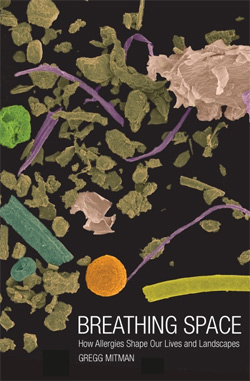During the late 1800s and early 1900s, as American cities grew increasingly polluted and crowded, wealthy Americans started retreating to clean, spacious suburban settings. Once there, they hired landscapers who planted bucolic gardens where people could walk in peace, see flowers and trees, and breathe clean, fresh air.
They may have gotten what they wanted in terms of peace and beauty, but the air wasn’t quite up to snuff. Although it didn’t carry the stench of garbage, disease, or manufacturing, it did carry something else they didn’t want: lots of pollen. Those cultivated vistas helped make hay fever an ever-growing affliction.
Still, nobody wanted to get rid of the gardens. So they prospered, and people continued to spread throughout the country, building new homes and roads and railways, and planting more flowers and trees. And allergies got worse.
In the end, it wasn’t so much what people planted, but the soil they disturbed. All that human activity — the traveling and building and developing — stimulated growth of one of the most despised plants of all: ragweed. Flourishing opportunistically just about everywhere but in the mountains, and producing egregious amounts of pollen, the plant quickly became the primary contributor to hay fever. During the early 1900s, communities and cities passed anti-weed laws and during summers hired the unemployed to pull piles and piles of it from vacant city lots and suburban roadsides. But these efforts hardly made a dent in the growing quantities of pollen swirling in the air. It was too late.
So the story goes in Gregg Mitman’s recently published book Breathing Space: How Allergies Shape Our Lives and Landscapes. In it, the medical historian describes the many ways that allergy’s rise “is directly connected to changes in the natural and built environment over the last 150 years.”
Allergy is indeed still on the rise. Today, 40 to 50 million Americans suffer from allergies — more than double the number that did in the 1970s — and most of them have hay fever, according to the American Academy of Allergy, Asthma & Immunology.
The problem isn’t just the ever-increasing quantities of pollen. Allergies and asthma (which results from allergies in about 50 percent of cases) are linked to many other well-known causes like nuts, mold, latex, dust mites, and smoke, plus various lesser-known ones. Did you know, for instance, that cockroach droppings are a primary reason for the increasing incidence of allergy and asthma among America’s inner-city poor? Or that some scientists suspect antibacterial cleansers have not only increased the problem of antibiotic resistance but also made the immune system overly sensitive to allergens?
In line with this “hygiene hypothesis,” research is now emerging that treating children with antibiotics eradicates bacteria that protect us from some allergies and asthma. Recent animal studies by researchers at University of Michigan back up epidemiologic studies that found strong connections between antibiotic treatment and the later development of asthma and allergies.
Now researchers at NYU School of Medicine are learning that Helicobacter pylori, a bacterium had been the dominant organism in our stomach for tens of thousands of years, is disappearing as an apparent result of antibiotics and improved sanitation. Less than 10 percent of children carry the organism in industrialized countries today, compared to about 90 percent of children, usually infected by age 5, in developing countries.
This bacterium can’t disappear from us without consequences, says lead investigator Martin J. Blaser, M.D. To be sure, this news is not all bad: H. pylori is responsible for stomach cancer and peptic ulcers. But Blaser and colleagues have also found that it provides some protection against pollen and mold allergies, and reduces the incidence of asthma by 40 percent among children under the age of 15.
Thanks to research like this, we learn more all the time about how allergies develop, but the evolution of allergies remains at least somewhat of a mystery. In his book, Mitman teaches us that “allergy cannot be isolated as a disease.” Rather, as he describes it, allergy is a part of our complex relationship with the physical, social, and economic world we live in. Place is the nexus upon which, he alerts us, the “interrelationships between bodies and environments are constantly being made and remade.”
This idea of relationships becomes ever more important since most allergies are inherited — once we develop them, we increase the likelihood that our unlucky children will have them, too. • 20 December 2007
SOURCES: Chen Y, Blaser MJ. Inverse associations of Helicobacter pylori with asthma and allergy. Arch Intern Med. 2007;167:821-7. Noverr MC, Falkowski NR, McDonald RA, McKenzie AN, Huffnagle GB. Development of allergic airway disease in mice following antibiotic therapy and fungal microbiota increase: role of host genetics, antigen, and interleukin-13. Infect Immun. 2005;73:30-8. Breathing Space: How Allergies Shape Our Lives and Landscapes by Gregg Mitman (Yale University Press, 2007).




